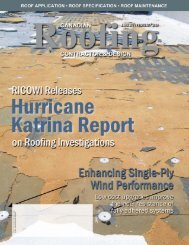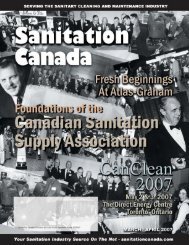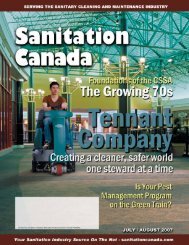here - Perks Publications Inc.
here - Perks Publications Inc.
here - Perks Publications Inc.
Create successful ePaper yourself
Turn your PDF publications into a flip-book with our unique Google optimized e-Paper software.
HEARING PROTECTOR WEAR-TIME EVALUATION TOOL<br />
AVAILABLE FROM HOWARD LEIGHT<br />
Many noise-exposed workers<br />
fail to realize how damaging it can<br />
be to remove their hearing protection<br />
even for a few minutes. A new<br />
wear-time evaluation tool, available<br />
free from Howard Leight by<br />
Sperian, can help alert them to this<br />
danger. This device is a simple disc,<br />
one side of which identifies the<br />
optimal amount of attenuation a<br />
hearing protection device (HPD)<br />
will provide over an eight-hour shift<br />
if it is removed for various lengths<br />
of time. The reverse side of the<br />
Wear-Time Evaluator offers advice<br />
on selecting the proper hearing protector.<br />
“This question comes up again<br />
and again in both our hearing conservation<br />
seminars and in everyday<br />
discussions with hearing conservation<br />
program managers,” said<br />
Renee Bessette, marketing manager<br />
for Sperian Hearing Protection LLC,<br />
formerly Bacou-Dalloz Hearing<br />
Safety Group. “How much protection<br />
is lost by removing a hearing<br />
protector even for five minutes during<br />
an eight-hour shift? The Wear-<br />
Time Evaluator provides the answer<br />
in a very simple and meaningful<br />
way.”<br />
Intended primarily as a training<br />
device, the outer ring of the larger<br />
disc shows a range of decibel (dB)<br />
levels of attenuation provided by<br />
various hearing protectors (i.e. their<br />
published Noise Reduction Rating,<br />
or NRR), while the smaller disc<br />
shows time increments of five, 10,<br />
15 and 30 minutes. To determine<br />
how much protection is reduced by<br />
removing an HPD during a work<br />
shift for a cumulative amount of<br />
time, simply align the pointer to the<br />
appropriate dB level, or NRR on the<br />
Continued From Page 10<br />
outer ring, and read the effective<br />
protection in the cut-out next to the<br />
time increments. The wheel utilizes<br />
a five decibel exchange rate, per the<br />
OSHA standard,<br />
“For example, removing a 30<br />
NRR earplug for only five minutes<br />
reduces effective protection to only<br />
26 dB. Remove the earplug for half<br />
an hour, and the worker is only receiving<br />
18 dB of effective protection<br />
during his or her eight-hour<br />
work shift. This loss can easily shift<br />
the balance from adequate protection<br />
to growing noise-induced hearing<br />
loss.”<br />
The reverse side of the Wear-<br />
Time Evaluator is no less valuable,<br />
said Bessette. It lists a number of<br />
factors to consider when selecting<br />
hearing protectors for a workforce,<br />
including size, comfort, communication<br />
needs and desired noise reduction.<br />
By moving the inner disc<br />
to each, key selection information<br />
is revealed.<br />
Howard Leight Wear-Time<br />
Evaluators are available free to<br />
safety officers and educators by<br />
contacting Sperian Customer Care<br />
at (800) 430-5490.<br />
HILTI X-76 PUNCH THROUGH RESISTANT FASTENING TOOL<br />
and money.<br />
Covered by the Hilti Lifetime<br />
Service Warranty, the X-76 PTR fastening<br />
tool will be serviced quickly<br />
and reliably, if needed, with no additional<br />
cost for two years. During<br />
the lifetime repair cost limit, which<br />
begins after the two-year no cost period,<br />
the tool will have a maximum<br />
repair cost of no greater than 30 per<br />
cent of the tool’s then-current list<br />
price. Once the tool is repaired, it<br />
receives an additional six months<br />
of no cost service. The lifetime<br />
manufacturer’s warranty covers the<br />
tool against manufacturer defects for<br />
the life of the tool (some limitations<br />
apply. Contact Hilti for details).<br />
For more information, contact<br />
Hilti (Canada) Corporation at (800)<br />
363-4458 or visit the company’s<br />
web site www.ca.hilti.com.<br />
FOLLANSBEE ROOFS TOP HISTORIC RESTORATION PROJECT<br />
Follansbee TCSII® roofs top<br />
the top two main residential<br />
buildings at Stonington Commons,<br />
an historic restoration<br />
project that shaped an upscale<br />
mixed-use development from<br />
the nineteenth-century foundry<br />
in Stonington, CT. During construction<br />
in 2003, fire engulfed<br />
three buildings at the site, but<br />
the project team forged ahead.<br />
Stonington Commons is a<br />
$40 million mixed-use complex<br />
that rose from the ashes on historic<br />
Water Street. The site features<br />
seven, new single-family<br />
homes, 34 high-end condominiums,<br />
a yacht club and marina,<br />
800 feet of waterfront paths, and<br />
room for street-level retail shops.<br />
Local residents originally resisted<br />
the construction project<br />
because of their desire to maintain<br />
the town’s historic integrity.<br />
“We specified Follansbee<br />
TCS II for contextual reasons,”<br />
said Project Architect, Yetsuh<br />
Frank of Beyer Blinder Belle<br />
Architects and Planners, LLP.<br />
“The pewter colour and type of<br />
metal are common for industrial<br />
building. These had been industrial<br />
buildings in the past and<br />
TCS II fit that flavour in the buildings’<br />
new life.”<br />
Over 50,000 sq. feet of<br />
Follansbee TCS II Terne Coated<br />
Stainless roofing material tops<br />
the two main residential buildings<br />
– the Atwood Machine<br />
Company building (1906) and<br />
the Trumbull building (1849) –<br />
at Stonington Commons.<br />
“TCS II is one of the few<br />
materials that can stand up to a<br />
coastal environment,” Frank<br />
continues. “Follansbee is one of<br />
the largest manufacturers in the<br />
industry, so t<strong>here</strong> was no question<br />
as to the quality of material<br />
or the support available.”<br />
In 2003, during the demolition<br />
phase of the project, fire<br />
spread through the wooden interior<br />
structure of the Atwood<br />
building. The Foundry, which<br />
was used during the War of<br />
1812, and the Trumbull building<br />
also caught fire. The fire set<br />
construction back at least one<br />
year and entirely changed the<br />
scope of the project: instead of<br />
an historic restoration, parts of<br />
the project called for historic<br />
replication.<br />
The Atwood Machine Company,<br />
made entirely from brick<br />
and wooden supports, had collapsed<br />
from the fire. The building<br />
that stands now is entirely<br />
new and made to replicate the<br />
original. “When I look at the<br />
Atwood building, it’s almost astonishing<br />
how accurate it turned<br />
out,” Frank said.<br />
The Trumbull Building,<br />
made from granite, mostly withstood<br />
the fire. Only the top third<br />
of the building was lost. The<br />
project team, continuing in their<br />
commitment to historical accuracy,<br />
tracked down the original<br />
Rhode Island quarry that produced<br />
the granite used to construct<br />
the building. The new<br />
parts of the building blend<br />
seamlessly with the old. The<br />
project was complete in the fall<br />
of 2005.<br />
TCS II formed the standing<br />
seam roofs, wall panels, gutters,<br />
downspouts and window, door<br />
and cornice trim.<br />
TCS II is an architectural<br />
stainless steel coated with<br />
Follansbee’s patented ZT ® (zinc/<br />
tin) alloy. As a result of<br />
Follansbee’s extensive<br />
metallurgic research, TCS II does<br />
not require painting and is de-<br />
Continued On Page 23<br />
Canadian Roofing Contractor & Design - OCTOBER / NOVEMBER 2007 11










